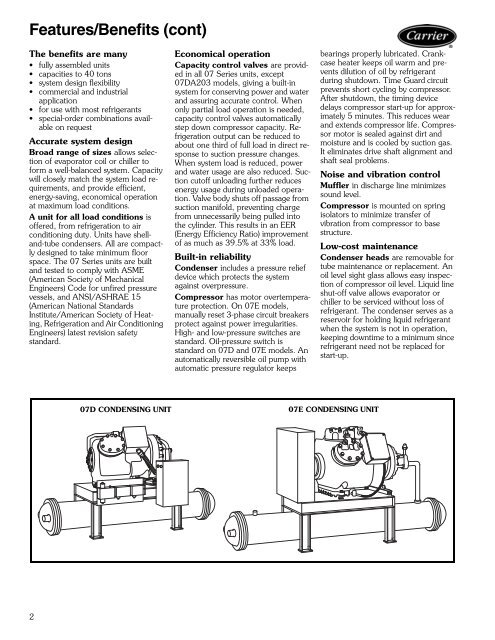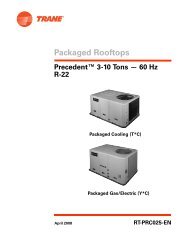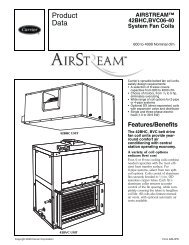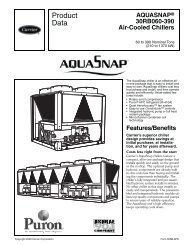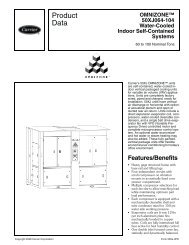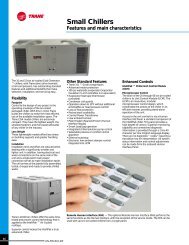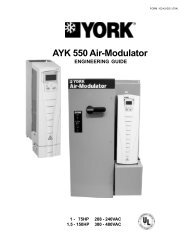Product Data
Product Data
Product Data
You also want an ePaper? Increase the reach of your titles
YUMPU automatically turns print PDFs into web optimized ePapers that Google loves.
Features/Benefits (cont)<br />
The benefits are many<br />
• fully assembled units<br />
• capacities to 40 tons<br />
• system design flexibility<br />
• commercial and industrial<br />
application<br />
• for use with most refrigerants<br />
• special-order combinations available<br />
on request<br />
Accurate system design<br />
Broad range of sizes allows selection<br />
of evaporator coil or chiller to<br />
form a well-balanced system. Capacity<br />
will closely match the system load requirements,<br />
and provide efficient,<br />
energy-saving, economical operation<br />
at maximum load conditions.<br />
A unit for all load conditions is<br />
offered, from refrigeration to air<br />
conditioning duty. Units have shelland-tube<br />
condensers. All are compactly<br />
designed to take minimum floor<br />
space. The 07 Series units are built<br />
and tested to comply with ASME<br />
(American Society of Mechanical<br />
Engineers) Code for unfired pressure<br />
vessels, and ANSI/ASHRAE 15<br />
(American National Standards<br />
Institute/American Society of Heating,<br />
Refrigeration and Air Conditioning<br />
Engineers) latest revision safety<br />
standard.<br />
2<br />
Economical operation<br />
Capacity control valves are provided<br />
in all 07 Series units, except<br />
07DA203 models, giving a built-in<br />
system for conserving power and water<br />
and assuring accurate control. When<br />
only partial load operation is needed,<br />
capacity control valves automatically<br />
step down compressor capacity. Refrigeration<br />
output can be reduced to<br />
about one third of full load in direct response<br />
to suction pressure changes.<br />
When system load is reduced, power<br />
and water usage are also reduced. Suction<br />
cutoff unloading further reduces<br />
energy usage during unloaded operation.<br />
Valve body shuts off passage from<br />
suction manifold, preventing charge<br />
from unnecessarily being pulled into<br />
the cylinder. This results in an EER<br />
(Energy Efficiency Ratio) improvement<br />
of as much as 39.5% at 33% load.<br />
Built-in reliability<br />
Condenser includes a pressure relief<br />
device which protects the system<br />
against overpressure.<br />
Compressor has motor overtemperature<br />
protection. On 07E models,<br />
manually reset 3-phase circuit breakers<br />
protect against power irregularities.<br />
High- and low-pressure switches are<br />
standard. Oil-pressure switch is<br />
standard on 07D and 07E models. An<br />
automatically reversible oil pump with<br />
automatic pressure regulator keeps<br />
07D CONDENSING UNIT 07E CONDENSING UNIT<br />
bearings properly lubricated. Crankcase<br />
heater keeps oil warm and prevents<br />
dilution of oil by refrigerant<br />
during shutdown. Time Guard circuit<br />
prevents short cycling by compressor.<br />
After shutdown, the timing device<br />
delays compressor start-up for approximately<br />
5 minutes. This reduces wear<br />
and extends compressor life. Compressor<br />
motor is sealed against dirt and<br />
moisture and is cooled by suction gas.<br />
It eliminates drive shaft alignment and<br />
shaft seal problems.<br />
Noise and vibration control<br />
Muffler in discharge line minimizes<br />
sound level.<br />
Compressor is mounted on spring<br />
isolators to minimize transfer of<br />
vibration from compressor to base<br />
structure.<br />
Low-cost maintenance<br />
Condenser heads are removable for<br />
tube maintenance or replacement. An<br />
oil level sight glass allows easy inspection<br />
of compressor oil level. Liquid line<br />
shut-off valve allows evaporator or<br />
chiller to be serviced without loss of<br />
refrigerant. The condenser serves as a<br />
reservoir for holding liquid refrigerant<br />
when the system is not in operation,<br />
keeping downtime to a minimum since<br />
refrigerant need not be replaced for<br />
start-up.


